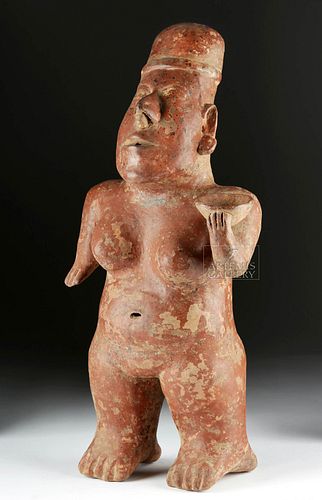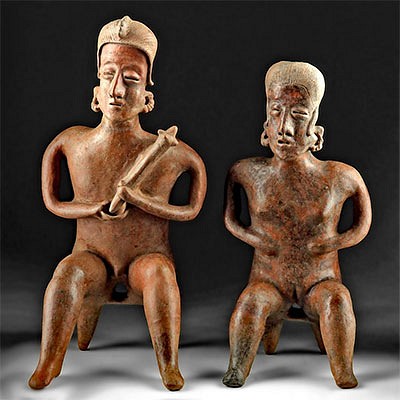Huge Jalisco Redware Nude Woman, ex-Hollywood
Lot 157
About Seller
Artemis Fine Arts
686 S Taylor Ave, Ste 106
Louisville, CO 80027
United States
Selling antiquities, ancient and ethnographic art online since 1993, Artemis Gallery specializes in Classical Antiquities (Egyptian, Greek, Roman, Near Eastern), Asian, Pre-Columbian, African / Tribal / Oceanographic art. Our extensive inventory includes pottery, stone, metal, wood, glass and textil...Read more
Categories
Estimate:
$3,600 - $5,400
Absentee vs Live bid
Two ways to bid:
- Leave a max absentee bid and the platform will bid on your behalf up to your maximum bid during the live auction.
- Bid live during the auction and your bids will be submitted real-time to the auctioneer.
Bid Increments
| Price | Bid Increment |
|---|---|
| $0 | $25 |
| $300 | $50 |
| $1,000 | $100 |
| $2,000 | $250 |
| $5,000 | $500 |
| $10,000 | $1,000 |
| $20,000 | $2,500 |
| $50,000 | $5,000 |
| $100,000 | $10,000 |
| $200,000 | $20,000 |
About Auction
By Artemis Fine Arts
Mar 25, 2021
Set Reminder
2021-03-25 10:00:00
2021-03-25 10:00:00
America/New_York
Bidsquare
Bidsquare : CLEARANCE Antiquities | Ethnographic Art
https://www.bidsquare.com/auctions/artemis-gallery/clearance-antiquities-ethnographic-art-6663
Featuring discounted pricing on Asian art, Classical antiquities from Egypt, Greece, Italy, and the Near East...plus Pre-Columbian, Tribal, Russian Icons, Spanish Colonial, Fine Art, more! Artemis Fine Arts info@artemisfinearts.com
Featuring discounted pricing on Asian art, Classical antiquities from Egypt, Greece, Italy, and the Near East...plus Pre-Columbian, Tribal, Russian Icons, Spanish Colonial, Fine Art, more! Artemis Fine Arts info@artemisfinearts.com
- Lot Description
**Originally Listed At $3000**
Pre-Columbian, West Mexico, Jalisco, El Arenal style, Protoclassic Period, ca. 100 BCE to 250 CE. A tall female figure of substantial form standing upon a pair of arching feet and stocky legs. Her slightly distended torso, ample hips, and delineated female genitalia are suggestive of pregnancy, with an impressed navel and globular breasts emphasizing her feminine physique. She stands upright with a rigid posture and rounded shoulders with attenuated arms, the right draped next to her side and her right holding aloft a simple bowl. The finely-stylized, elongated, and skyward-staring visage is comprised of almond-shaped eyes, a prominent nose with a barrel-shaped nose ring, tall ears with accompanying ear spools, and full cheeks and chin, all beneath a simple head band. Her body boasts a red-brown slip exterior, though traces of cream-hued pigment around her waist and on her eyes and ear spools suggest she may have once exhibited even more elaborate decorations. A fabulous example from ancient Western Mexico! Size: 10.75" W x 22.25" H (27.3 cm x 56.5 cm).
Clay figures like this example are the only remains that we have today of this sophisticated and unique culture in West Mexico. The indigenous made no above-ground monuments or sculptures, at least that we know of, which is in stark contrast to developments elsewhere in ancient Mesoamerica. Instead, they developed a widely-used method of burial known as shaft tombs.
The dead were buried down shafts - 3 to 20 meters deep - that were dug vertically or near vertically through "tepetate" - the volcanic tuff that makes up the geology of the region. The base of the shaft would open into one or more horizontal chambers with a low ceiling. These shafts were almost always dug beneath a dwelling, probably a family home, and seem to have been used as family mausoleums, housing the remains of many related individuals. Their tombs were their lasting works of art: skeletons arrayed radially with their feet positioned inward, and clay offerings, like this one, placed alongside the walls facing inward, near the skulls.
This is a figure made to be placed inside those mausoleums, perhaps to mediate between the worlds of the living and the dead. However, we unfortunately lack the information we would need to understand what these figures were truly made for. Do they represent everyday people, even individuals? Are they religious? Were they created to mediate between the living and the dead? Whatever their purpose, today they are beautiful artwork and reminders of the mysterious past.
A similar, seated example with dense painted embellishments hammered for $7,200 at Sotheby's, New York "Arcade, Furniture, & Decorations" Auction (June 22, 2007, lot 81): http://www.sothebys.com/en/auctions/ecatalogue/2007/arcade-furniture-decorations-n08334/lot.81.html
Provenance: private Hawaii, USA collection; ex-private T. Misenhimer collection, Beverly Hills, California, USA, between 1970 to 2008
All items legal to buy/sell under U.S. Statute covering cultural patrimony Code 2600, CHAPTER 14, and are guaranteed to be as described or your money back.
A Certificate of Authenticity will accompany all winning bids.
We ship worldwide and handle all shipping in-house for your convenience.
#132665Head, body, and bowl repaired from several large pieces with areas of restoration, resurfacing, and overpainting along break lines. Surface wear and abrasions commensurate with age as expected, minor nicks and losses to feet, arms, bowl, ears, and head, with flaking and chipping to pigmentation. Nice earthen and mineral deposits throughout.Condition
- Shipping Info
-
All shipping is handled in-house for your convenience. Your invoice from Artemis Gallery will include shipping calculation instructions. If in doubt, please inquire BEFORE bidding for estimated shipping costs for individual items.
-
- Buyer's Premium



 EUR
EUR CAD
CAD AUD
AUD GBP
GBP MXN
MXN HKD
HKD CNY
CNY MYR
MYR SEK
SEK SGD
SGD CHF
CHF THB
THB


















